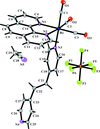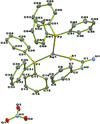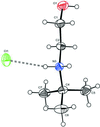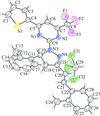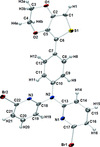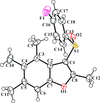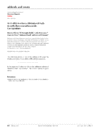issue contents
July 2014 issue

Cover illustration: The alkyne dicobalt clusters [Co2(C8H11BrO3)(CO)6] and [Co2(C12H16Br2O4)(CO)6] feature asymmetric (illustrated) or symmetric alkynes, classic tetrahedral C2Co2 cluster cores, with each carbon atom of the alkyne bridging two Co atoms, and highly distorted octahedral geometries. Inversion dimers are found in the crystal structure of the asymmetric cluster mediated by hydroxyl-O-H O(hydroxyl) hydrogen bonds. See: McAdam, Moratti, Robinson, Simpson & Stanley [Acta Cryst. (2014). E70, 9-13].
O(hydroxyl) hydrogen bonds. See: McAdam, Moratti, Robinson, Simpson & Stanley [Acta Cryst. (2014). E70, 9-13].
editorial
international union of crystallography
research communications
Download citation


Download citation


The structures of two alkyne-hexacarbonyl-dicobalt complexes are reported, each with potential ATRP initiator substrates as substituents on the alkynes. The complexes each form tetrahedral C2Co2 cluster cores with classical sawhorse conformations, while a feature of the crystal packing is the formation of inversion dimers for both molecules.
Download citation


Download citation


The basic building units of the hydrous periodate Pb3(IO4(OH)2)2 are three Pb2+ cations and two IO4(OH)23− anions. The octahedral anions are arranged in a distorted hexagonal rod packing, with the cations (each with a coordination number of eight) located in between.
CCDC reference: 1004265
Download citation


Download citation


The title molecules, HL1 and HL2, differ in their conformation with the pyridine ring being inclined to the pyrazine ring by 61.34 (6) and 84.33 (12)°, respectively. The crystal packing is also slightly different, with molecules of HL1 linked by pairs of N—H⋯N hydrogen bonds, forming inversion dimers, while for HL2 molecules are linked by N—H⋯N and C—H⋯N hydrogen bonds, forming chains along [010].
Download citation


Download citation


The title compound, a hydrated copper acetate complex of the ligand N-[(pyridin-4-yl)methyl]pyrazine-2-carboxamide, has a metal-organic framework (MOF) structure with a 10 (3) network topology. The water molecules are located in the cavities of the framework and linked to it by O—H⋯O hydrogen bonds.
CCDC reference: 1004264
Download citation


Download citation


In the title layered, mixed-valence ammonium vanadium tellurite, the VV atom are tetrahedrally coordinated and the VIV atoms adopt distorted octahedral coordination geometries. The presumed TeIV lone pairs of electrons are directed inwards into lacunae in the double polyhedral layers.
CCDC reference: 1004307
Download citation


Download citation


Solvent-dependent outcomes are noted in co-crystallization experiments between DABCO and 4-nitrobenzoic acid with mono- and diprotonated forms of DABCO are isolated.
Download citation


Download citation


The platinum(II) complex with notable antitumor activity shows a slightly distorted square-planar coordination and intramolecular C—H⋯Cl and intermolecular N—H⋯Cl and C—H⋯O hydrogen bonds.
CCDC reference: 1004305
Download citation


Download citation


2,5-Diazido-1,4-phenylene diacetate and dibutyrate are the first structurally characterized representatives with a trans-diazidophenylene entity. Both molecules possess inversion symmetry; however, the compounds crystallize in different crystal systems (triclinic versus monoclinic).
inorganic compounds
Download citation


Download citation


Download citation


Download citation


Download citation


Download citation


Download citation


Download citation


Download citation


Download citation


Download citation


Download citation


Download citation


Download citation


Download citation


Download citation


metal-organic compounds
Download citation


Download citation


Download citation


Download citation


Download citation


Download citation


Download citation


Download citation


Download citation


Download citation


Download citation


Download citation


Download citation


Download citation


Download citation


Download citation


Download citation


Download citation


Download citation


Download citation


Download citation


Download citation


Download citation


Download citation


Download citation


Download citation


Download citation


Download citation


Download citation


Download citation


Download citation


Download citation


Download citation


Download citation


Download citation


Download citation


Download citation


Download citation


Download citation


Download citation


Download citation


Download citation


Download citation


Download citation


Download citation


Download citation


Download citation


Download citation


Download citation


Download citation


Download citation


Download citation


Download citation


Download citation


organic compounds
Download citation


Download citation


Download citation


Download citation


Download citation


Download citation


Download citation


Download citation


Download citation


Download citation


Download citation


Download citation


Download citation


Download citation


Download citation


Download citation


Download citation


Download citation


Download citation


Download citation


Download citation


Download citation


Download citation


Download citation


Download citation


Download citation


Download citation


Download citation


Download citation


Download citation


Download citation


Download citation


Download citation


Download citation


Download citation


Download citation


Download citation


Download citation


Download citation


Download citation


Download citation


Download citation


Download citation


Download citation


Download citation


Download citation


Download citation


Download citation


Download citation


Download citation


Download citation


Download citation


Download citation


Download citation


Download citation


Download citation


Download citation


Download citation


Download citation


Download citation


Download citation


Download citation


Download citation


Download citation


Download citation


Download citation


Download citation


Download citation


Download citation


Download citation


Download citation


Download citation


Download citation


Download citation


Download citation


Download citation


Download citation


Download citation


Download citation


Download citation


Download citation


Download citation


Download citation


Download citation


Download citation


Download citation


Download citation


Download citation


Download citation


Download citation


Download citation


Download citation


Download citation


Download citation


Download citation


Download citation


Download citation


Download citation


Download citation


Download citation


Download citation


Download citation


Download citation


Download citation


Download citation


Download citation


Download citation


Download citation


Download citation


Download citation


Download citation


Download citation


Download citation


Download citation


Download citation


Download citation


Download citation


Download citation


Download citation


Download citation


Download citation


Download citation


Download citation


Download citation


Download citation


Download citation


Download citation


Download citation


Download citation


Download citation


Download citation


Download citation




 journal menu
journal menu




















































